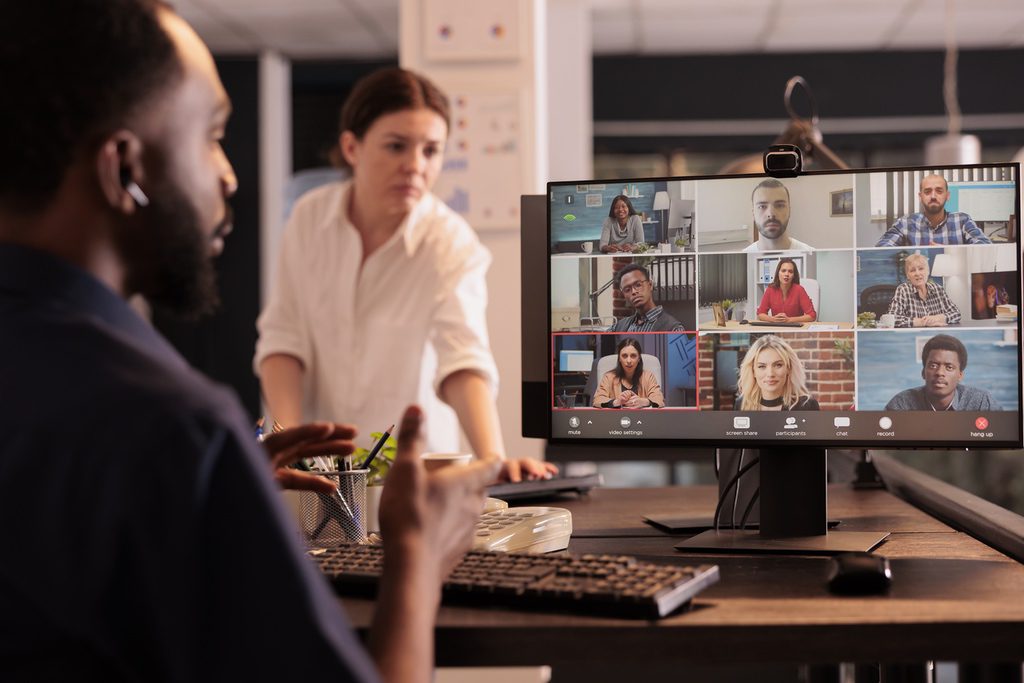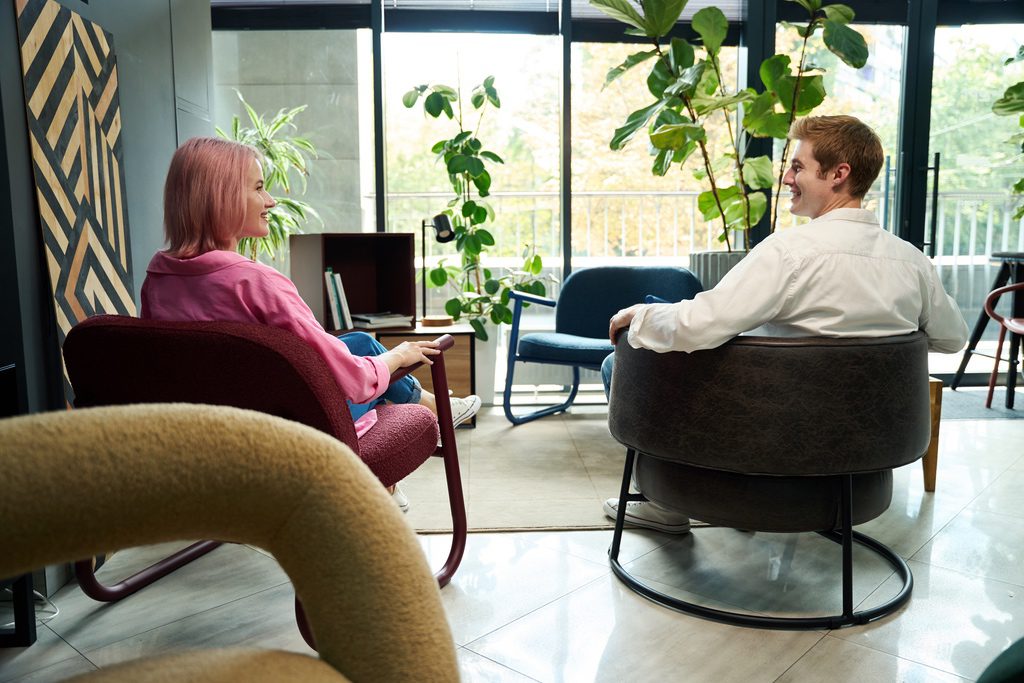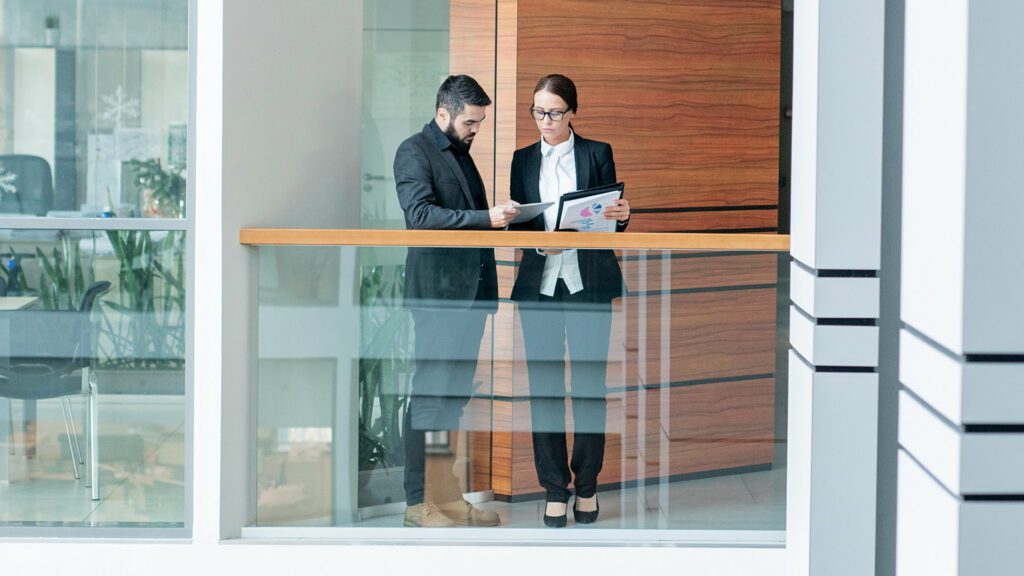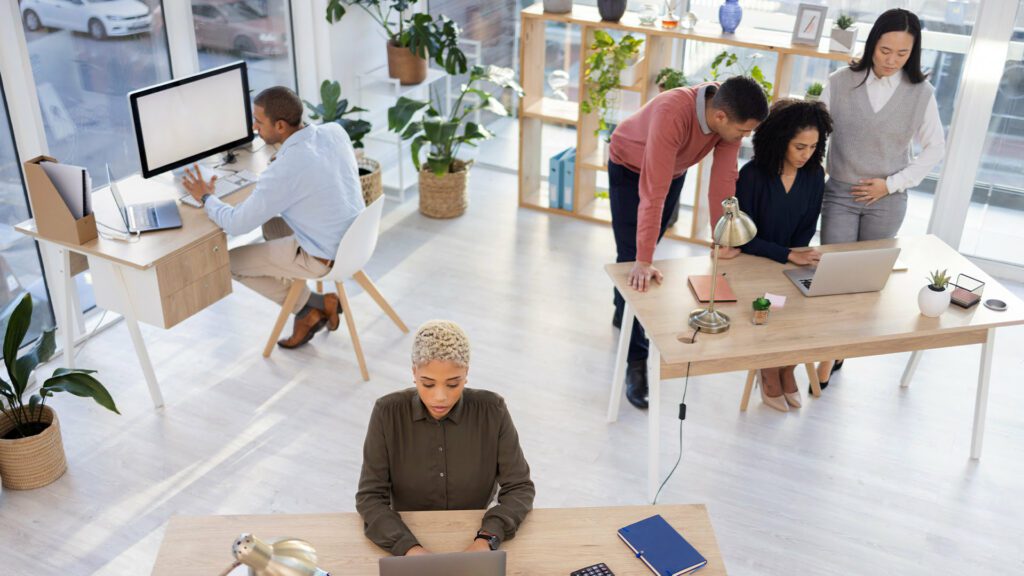Summary
- Making the office a comfortable and supportive environment encourages employees to voluntarily come in, rather than mandatory attendance (which can negatively impact productivity and morale).
- Implement a human-centric design that emphasizes comfort, health, and well-being with flexible hot-desking, intuitive layouts, purpose-built spaces, and synchronized, scalable technologies.
- Equip your office with high-quality video conferencing systems, real-time collaboration software, and reliable tech support to enhance communication between remote and in-office workers.
- Offer additional amenities like quiet zones, relaxation areas, and professional development opportunities to increase the office’s appeal and support employees’ growth.
- Creating a workplace that facilitates everyone’s best work should be a two-way conversation between employers and employees. Gather employee feedback through surveys to understand their needs and collaborate with ET Group’s technology consultants to build a purposeful and effective environment.
Encourage Employees to Come Into Work by Making the Office More Useful
Although the benefits of hybrid and remote work are well documented, office attendance remains important for many employers. But since mandatory attendance can feel punitive and impact morale, we believe it’s more effective to encourage employees to choose to come into work—and the easiest way to do that is to make your space a place where they feel comfortable and supported.
Below, our team guides you through several key elements of making your office more useful for modern workers and their needs. We’ll show you why the design of your space, the technology you use, and the amenities you provide can all help your team members do their best work (and make them excited about visiting the office to do it).
Creating a Useful Workplace Environment
The key to making your office more appealing to team members is creating genuine value for them. Here are three easy areas to focus on where you can make effective improvements quickly:
Human-Centric Space Design
Human-centric space design is about involving and centering people in the design process. Making the end users of a space part of the design process is one of the most effective ways to support their comfort, health, and overall well-being. It’s about creating environments that are not only functional and aesthetically pleasing but also deeply attuned to the needs and experiences of the occupants.
Human-centered workplaces are typically comfortable, adaptable, and practical. They often involve the use of new technologies—but critically, these technologies must be integrated in ways that serve the people using them.
At ET Group, we design human-centric spaces for modern workplaces by making sure they are:
Flexible
Hot-desking solutions and modular layouts reduce unused real estate by allowing team members to drop in or out as needed, while providing more versatility for employees.
Intuitive
Prioritizing efficiency and ergonomics results in spaces that minimize confusion and distractions, promoting focus and productivity.
Purpose-Built
Identifying your organization’s unique needs and creating spaces that incorporate relevant technologies means your workplace is almost always the best place for employees to get work done.
Synchronized
Critically, any tools used in your space must be able to complement each other and connect when necessary. This is often one of the most difficult aspects of designing a space that serves the modern hybrid workforce—so if you want your employees to feel good about performing work in-office, it’s vital to ensure that the technology you invest in is compatible and scalable.
Learn More: How Audiovisual Consulting Provides Key Support for Hybrid Work Environments
Modern Collaboration Technology
The technology your office uses is what allows you to ensure seamless communication between remote and in-office team members. Improving this technology is not about discouraging remote work, which makes many employees happier and more productive—it’s about making sure the in-office experience you offer is comparable in terms of the comfort, focus, and satisfaction it provides.
Key elements of modern collaboration technology include:
High-Quality Video Conferencing Systems
Crystal clear sound and video with user-friendly hardware and software reduces friction and helps avoid delays—whether you’re using Webex, Zoom, Microsoft Teams, or another solution.
Real-Time Collaboration Software
Mural, Vidcast, and other tools make it easy for team members to work on projects together, no matter where they’re located.
Reliable Tech Support & Network Infrastructure
Remote support solutions and onsite technical assistance make working from the office the least stressful option for team members who experience technical difficulties when working remotely.
Other Amenities
Creating a purposeful, human-centric space gives employees a place that facilitates deep focus, and the right technology helps make it a frictionless environment—but a few extra incentives don’t hurt when you’re trying to make your office the most attractive place for people to work. Here are a few other recommendations:
Quiet Zones & Relaxation Areas
Designated quiet zones or relaxation areas with comfortable seating can offer employees a place to unwind or work without distractions. This is especially important in an open office layout.
Professional Development Opportunities
Host seminars, workshops, or classes in the office. This not only encourages personal and professional growth but also shows your investment in your employees’ future. We offer workshops for thriving in hybrid spaces that can further increase your ROI from upgrading your workplace by equipping team members with the skills and confidence to use the new technology effectively.
Encouraging Employee Engagement & Feedback
Before moving forward with any office renovations or upgrades, it’s vital to make sure you have a clear picture of your team’s needs and preferences. Try the following:
- Put out a survey to collect written feedback from employees about the features or amenities they need to feel supported in an office environment.
- Host workshops with cross-functional groups that can provide feedback.
- Work with a technology consultant who can research your organization and provide tailored recommendations on the solutions that will deliver the most value to your workforce.
Upgrade Your Office to Support Your Modern Workforce
The office should be a purposeful environment where employees feel value in going in to utilize the available tools and amenities available. If it isn’t useful to your team, you can’t expect them to show up—but creating an in-office experience that supports everyone’s best interests is both mutually beneficial and relatively straightforward.
We’re here to help you build a workplace that meets the needs of forward-thinking organizations and employees. Book a discovery call now to get in touch with an industry leader who can show you the best way to make your office a place where people genuinely want to work.
Frequently Asked Questions
How many employees still work in offices?
According to Forbes, less than 60% of employees currently work in-office. It’s estimated that 32.6 million Americans will work remotely by 2025.
Why do employees want hybrid and remote work?
98% of employees want to work remotely at least some of the time. The most popular reasons why include:
- Flexible hours
- Work-provided equipment
- Home office stipends
- Virtual team-bonding activities
How secure is hybrid and remote work?
It depends on the technology that you use to keep your team connected. Remote and hybrid work only pose a security risk when technology or employee knowledge is insufficient to meet the needs of the organization. Working with a technology consultant can identify these gaps and ensure that any hybrid technology you invest in addresses them.
Stay connected with us:
Follow ET Group on LinkedIn
Subscribe to ET Group’s YouTube Channel












